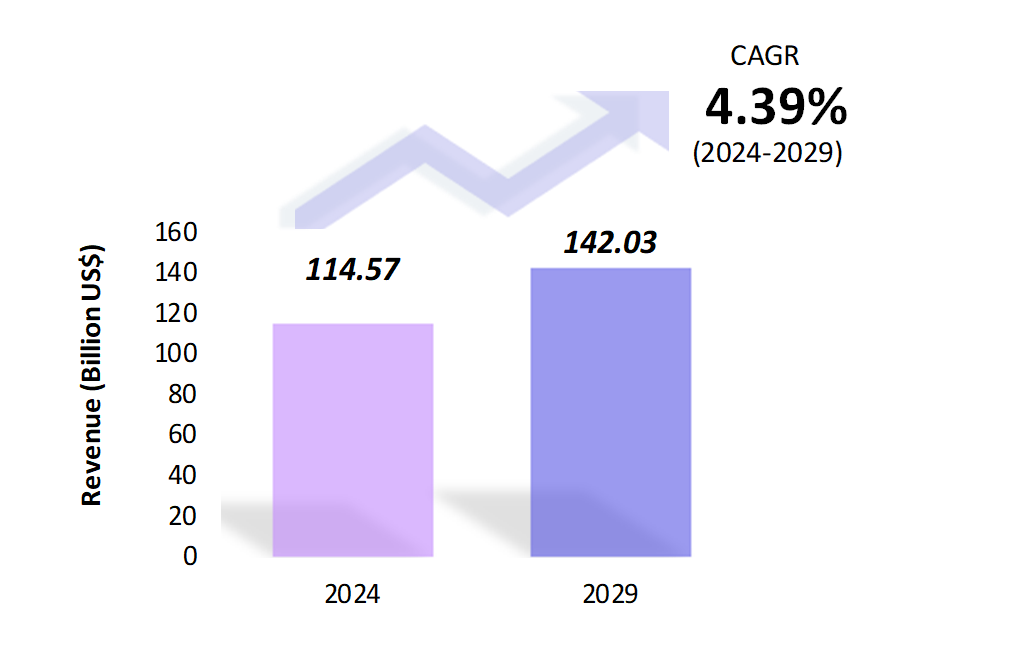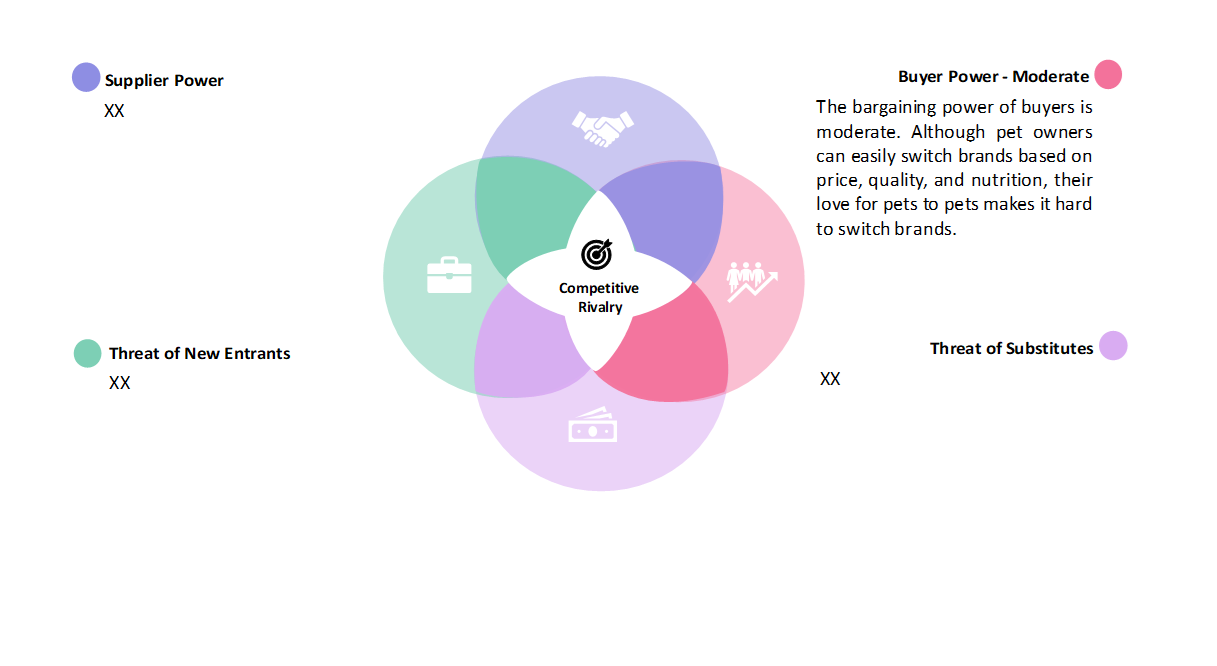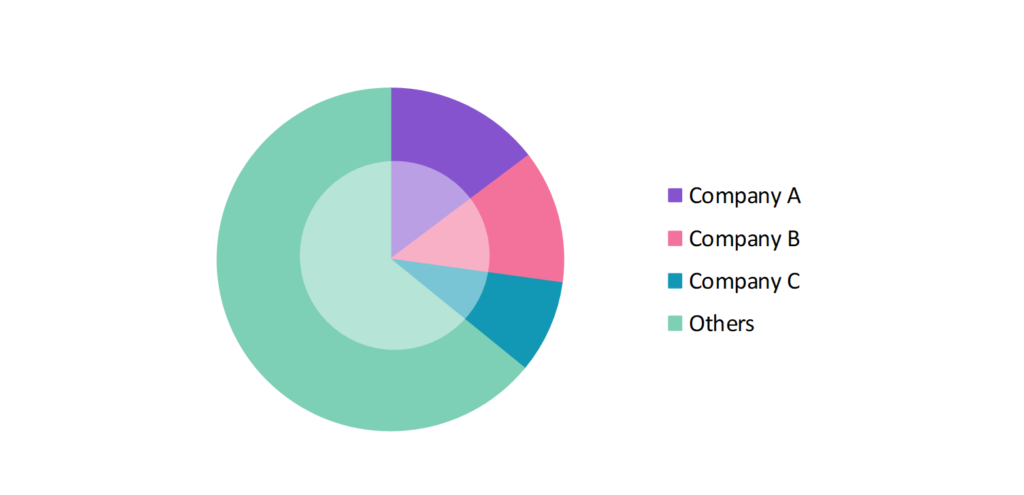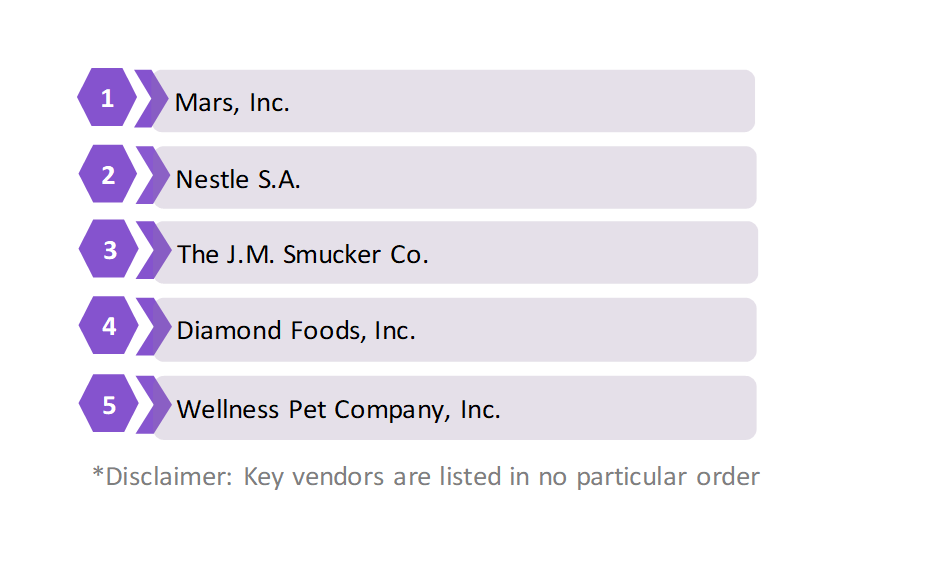Pet Food Market Outlook: Size, Share, Trends & Growth Analysis (2024-2029)
The report covers a comprehensive analysis segmented by Animal Type (Dogs, Cats, Others), by Form (Dry Pet Food, Wet Pet Food, Snacks & Treats), by Distribution Channel (Supermarkets/Hypermarkets, Specialty Stores, Online Channel, Others), by Source (Animal, Plant), by Geography (North America, South America, Asia Pacific, Europe, The Middle East, Africa).
Pet Food Market Snapshot

Pet Food Market Overview
The global pet food market is estimated to be at $114.57 Bn in 2024 and is anticipated to reach $142.03 Bn in 2029. The global pet food market is registering a CAGR of 4.39% during the forecast period 2024-2029. Pet food is a type of food that is specifically designed to meet the nutritional requirements of domesticated animals. This market includes the manufacturing, distribution, and retailing of pet food products, catering to the ever-growing population of pet owners worldwide.
Pet food is available in various formulations and forms, catering to different pet breeds, sizes, ages, and dietary needs. Some of the popular categories of pet food include puppy/kitten foods, adult maintenance foods, senior/geriatric foods, weight management foods, and specialty diets for pets suffering from specific health conditions or allergies. For example, Nestle Purina PetCare, a leading brand in the pet food market, offers a broad range of products such as Purina ONE, Purina Pro Plan, and Purina Dog Chow, each tailored to the specific dietary requirements and life stages of cats and dogs.
The pet food market encompasses a wide range of product formats, including dry kibble, wet canned foods, semi-moist foods, freeze-dried options, and an array of treats and supplements. These different formats cater to varying taste preferences, dental health requirements, and feeding routines of pets. For instance, Freshpet, Inc., a pioneering brand in the fresh pet food segment, produces refrigerated pet foods made with fresh, natural ingredients and minimal preservatives, appealing to pet owners seeking a more natural and less processed diet for their pets.
Pet Food Market Coverage
| Historical & Forecast Period | 2018-2029 |
| Base Year | 2023 |
| Forecast Period | 2024-2029 |
| Units | Billion US$ |
| Segments | Animal Type, Form, Distribution Channel, Source |
| Geographies | North America, South America, Asia Pacific, Europe, The Middle East, Africa |
| Key Vendors | Mars, Inc., Nestle S.A., The J.M. Smucker Co., Diamond Foods, Inc., Wellness Pet Company, Inc. |
Key Geographies of Pet Food Market, 2023

Porter’s 5 Forces Analysis of Pet Food Market

Pet Food Market Trends
Some companies now provide tailored meal plans based on a pet’s age, breed, activity level, and specific dietary requirements. This approach allows for a more precise delivery of essential nutrients, promoting better overall health and well-being for pets. Additionally, subscription-based pet food delivery services have emerged, offering convenience and customization options for busy pet owners.
Manufacturers are exploring eco-friendly and sustainable packaging solutions for their products to reduce their environmental impact. This includes the use of recyclable and biodegradable materials for packaging, as well as resealable and portion-controlled packaging options to minimize food waste and ensure its freshness. For instance, Stella & Chewy’s LLC pet food brand uses eco-friendly packaging made from plant-based materials, reducing their carbon footprint and minimizing waste.
As concerns over sustainability and environmental impact increase, manufacturers are exploring the use of novel protein sources such as insect-based proteins, plant-based proteins, and cultured or lab-grown proteins. These alternatives offer potential benefits in terms of reduced greenhouse gas emissions, land and water usage, and a more sustainable supply chain.
The demand for functional and therapeutic pet foods is on the rise. These products are formulated to address specific health conditions or provide targeted benefits for pets. Pet foods designed for joint health, weight management, or allergy relief are becoming increasingly popular. Manufacturers are incorporating ingredients like glucosamine, prebiotics, and specialized nutrients to cater to these specialized needs. For instance, Cymbiotika, LLC, a health supplement company, has launched a new line of four premium pet supplements to support optimal health: Probiotic, Calm, Hip & Joint, and Allergy & Immune Health.
The integration of technology and smart packaging is an emerging trend in the pet food industry. Some companies are exploring the use of QR codes, RFID tags, and smartphone apps to provide pet owners with detailed information about the product, nutrition facts, and even personalized feeding recommendations.
Pet Food Market Driving Factors
The trend of pet humanization is on the rise, which has led pet owners to spend more on high-quality and specialized pet food products. As pets are considered more like family members, their owners prioritize their pets’ well-being, which has driven the demand for nutritious and premium pet food options.
The increasing pet ownership globally, particularly among millennials and Gen Z consumers by the growing perception of pets as family members is leading to higher spending on pet food and related products. In 2023, for instance, the American Pet Products Association (APPA) reported that U.S. pet owners spent over $147 billion on pet food and treats, reflecting a significant increase of $10.2 billion from 2022.
The popularity of e-commerce and online pet food sales has also had a significant impact on the market. The convenience of online shopping and home delivery has made it easier for pet owners to access a wider range of pet food products, contributing to the growth of the market and increased competition among pet food brands.
The pet food market is influenced by changing consumer preferences and dietary trends. The growing demand for natural, organic, and grain-free pet food products has led to product innovation and diversification among pet food manufacturers. Consumers are increasingly aware of the ingredients in pet food and seek out products that align with their dietary beliefs and preferences.
Pet Food Market Challenges
The pet food market is becoming increasingly crowded as more pet owners demand high-quality and specialized products. Established companies such as Mars Petcare, Nestlé Purina, and Hill’s Pet Nutrition have long dominated the market due to their well-known brands and wide distribution networks. However, these companies are facing pressure from smaller brands that cater to specific markets or offer unique formulations.
The reliance on globally sourced ingredients and the impact of external factors, such as weather conditions, political tensions, or transportation issues, can lead to supply shortages and increased costs. These factors can negatively affect profitability and efficiency.
The manufacturing, labeling, and marketing of pet food products are subject to strict regulations to ensure safety and quality standards. For instance, in 2022, Mars Petcare, a player in the pet food market, had to recall several of its brands due to potential contamination concerns. This incident highlights the importance of stringent quality control measures.
The pandemic underscored the vulnerabilities in global supply chains, with delays and shortages affecting production and distribution. In 2023, logistical issues, such as shipping delays and container shortages, continued to impact the timely delivery of pet food products, particularly for companies reliant on international suppliers.
Pet Food Market – Key Industry News
- In April 2024, Cymbiotika, LLC, a health supplement company, launched a new line of four premium pet supplements to support optimal health: Probiotic+, Calm, Hip & Joint, and Allergy & Immune Health.
- In April 2024, Walker & Drake Ltd., a food and beverage manufacturing company, launched its new cold-pressed dog food formulated to give working dog breeds a balanced diet to help maintain energy and stamina levels.
- In April 2024, VEGDOG partnered with MicroHarvest GmbH to launch a new dog treat made of microbial protein. This product is intended for dogs who are intolerant to traditional protein sources.
Pet Food Market Competitive Landscape
The pet food market is a thriving industry that is shaped by numerous factors, such as product innovation, marketing strategies, and consumer trends. With the growing awareness of pet health and nutrition, companies are constantly trying to capture market share by offering a wide range of products tailored to meet the specific dietary needs of different pets.
The key players in the pet food market include corporations like Mars, Inc., Nestle S.A., The J.M. Smucker Co., Diamond Foods, Inc., Wellness Pet Company, Inc., and others. These companies dominate most of the market with their extensive product portfolios and established brand presence. These industry giants invest heavily in research and development to create new formulations that cater to the evolving preferences and nutritional requirements of pets, thereby maintaining their competitive edge.
However, the market also consists of smaller, niche players and emerging startups focusing on specialized diets, organic ingredients, or sustainable practices. These smaller companies often differentiate themselves through unique selling propositions, such as limited ingredient formulas, grain-free recipes, or environmentally friendly packaging. They carve out their niche in the competitive landscape and challenge the dominance of larger corporations. Overall, the pet food market remains dynamic and competitive, driven by innovation, consumer demand for quality and variety, and the ever-changing preferences of pet owners.
Pet Food Market Company Share Analysis, 2023 (%)

Pet Food Market – Key Companies

Reason to Buy from us

Table of Contents
| 1. Introduction |
|---|
| 1.1. Research Methodology |
| 1.2. Scope of the Study |
| 2. Market Overview / Executive Summary |
| 2.1. Global Pet Food Market (2018 – 2022) |
| 2.2. Global Pet Food Market (2023 – 2029) |
| 3. Market Segmentation |
| 3.1. Global Pet Food Market by Animal Type |
| 3.1.1. Dogs |
| 3.1.2. Cats |
| 3.1.3. Others |
| 3.2. Global Pet Food Market by Form |
| 3.2.1. Dry Pet Food |
| 3.2.2. Wet Pet Food |
| 3.2.3. Snacks & Treats |
| 3.3. Global Pet Food Market by Distribution Channel |
| 3.3.1. Supermarkets/Hypermarkets |
| 3.3.2. Specialty Stores |
| 3.3.3. Online Channel |
| 3.3.4. Others |
| 3.4. Global Pet Food Market by Source |
| 3.4.1. Animal |
| 3.4.2. Plant |
| 4. Regional Segmentation |
| 4.1. North America |
| 4.1.1. The U.S |
| 4.1.2. Canada |
| 4.1.3. Mexico |
| 4.2. South America |
| 4.2.1. Brazil |
| 4.2.2. Argentina |
| 4.2.3. Colombia |
| 4.2.4. Chile |
| 4.2.5. Rest of South America |
| 4.3. Asia Pacific |
| 4.3.1. China |
| 4.3.2. India |
| 4.3.3. Japan |
| 4.3.4. South Korea |
| 4.3.5. Rest of Asia Pacific |
| 4.4. Europe |
| 4.4.1. UK |
| 4.4.2. Germany |
| 4.4.3. Italy |
| 4.4.4. France |
| 4.4.5. Spain |
| 4.4.6. Rest of Europe |
| 4.5. The Middle East |
| 4.5.1. Turkey |
| 4.5.2. UAE |
| 4.5.3. Saudi Arabia |
| 4.5.4. Rest of the Middle East |
| 4.6. Africa |
| 4.6.1. Egypt |
| 4.6.2. South Africa |
| 4.6.3. Rest of Africa |
| 5. Value Chain Analysis of the Global Pet Food Market |
| 6. Porter Five Forces Analysis |
| 6.1. Threats of New Entrants |
| 6.2. Threats of Substitutes |
| 6.3. Bargaining Power of Buyers |
| 6.4. Bargaining Power of Suppliers |
| 6.5. Competition in the Industry |
| 7. Trends, Drivers, and Challenges Analysis |
| 7.1. Market Trends |
| 7.1.1. Market Trend 1 |
| 7.1.2. Market Trend 2 |
| 7.1.3. Market Trend 3 |
| 7.2. Market Drivers |
| 7.2.1. Market Driver 1 |
| 7.2.2. Market Driver 2 |
| 7.2.3. Market Driver 3 |
| 7.3. Market Challenges |
| 7.3.1. Market Challenge 1 |
| 7.3.2. Market Challenge 2 |
| 7.3.3. Market Challenge 3 |
| 8. Regulatory Landscape |
| 9. Competitive Landscape |
| 9.1. Mars, Inc. |
| 9.2. Nestle S.A. |
| 9.3. The J.M |
| 9.4. Diamond Foods, Inc. |
| 9.5. Wellness Pet Company, Inc. |
| 9.6. Company 6 |
| 9.7. Company 7 |
| 9.8. Company 8 |
| 9.9. Company 9 |
| 9.10. Company 10 |
Pet Food Market – Frequently Asked Questions (FAQs)
What is the current size of the global pet food market?
The market size for the global pet food market in 2024 is $114.57 Bn.
Who are the major vendors in the global pet food market?
The major vendors in the global pet food market are Mars, Inc., Nestle S.A., The J.M. Smucker Co., Diamond Foods, Inc., and Wellness Pet Company, Inc.
Which segments are covered under the global pet food market segments analysis?
This report offers in-depth insights into each animal type, form, distribution channel, and source.
